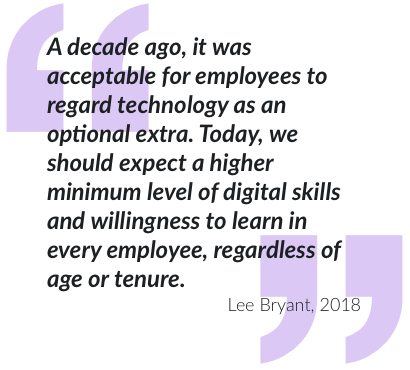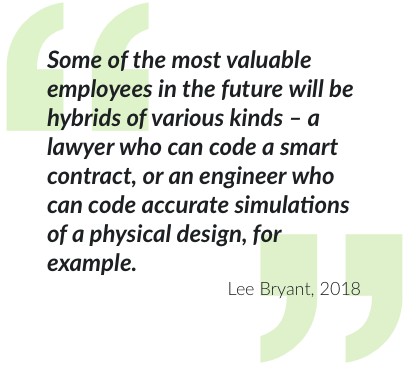Skills
Digital Workplace Futures
At the beginning of our social software journey the primary concern was not whether or not employees had the skills to make the best use of the new toolset, but rather whether or not they would know how to interact and behave. Large corporations took a defensive approach, blocking access to most external social platforms for employees.
Senior leaders struggled to understand the potential of these emerging technologies. Instead they fretted that employees lacked the judgement to use them responsibly.
This left employees behind in terms of learning new skills. These days most organisations embrace a more open, digital mindset, influenced by disruptive start-up ways of working. They understand that employees are not less productive when they engage in conversation.
There are new skills that the whole workforce needs to embrace, not to mention new mindsets that allow them to take advantage of the affordance of digital technology. The culture and structure of organisations are currently a barrier to an employee acquiring these skills alone. Those who have championed new skills over the years have done so against a background of learned helplessness.
But things are starting to change – with the introduction of smart technologies such as artificial intelligence and machine learning, coupled with new ways of working becoming embedded such as agile and lean, organisations are finally empowering learning agility as a core mindset for the future.
> Introduction
> Technology
> Ownership
> Community
> Design
> Collaboration
> Skills
> Change Agents
> Leadership
> Org Structure
> Measurement
> Conclusion
- SHIFT 1: Developing Good Judgement
- SHIFT 2: Coping with Information Overload
- SHIFT 3: Context Mastery
- NEXT: Digital Hybrids
- SHIFT 1: Developing Good Judgement
One of the most common discussions at the early stage of implementation for collaboration platforms focused on policing inappropriate content and ensuring appropriate behaviour. The fear that someone might share the wrong information with the wrong audience led to a preference for private groups, heavy moderation and blocking of any external social platforms.
Over the period of launch, most organisations were astonished that employees were able to conduct themselves in an appropriate way, with few incidents being escalated beyond the boundaries of communities. Risk and security personnel who were heavily involved in designing processes and policies for the earliest roll-outs found themselves involved less and less.
This approach sent conflicting messages to employees about how and where to work. Many felt it was safer to stick to pre-existing tools, especially if their team leads and senior leaders were not present on the platform, and therefore were unable to see their work progressing.
A1 #PS_Salon – No. And yet many aspects improved. #ESN is widely available in corporates, team collaboration tool-sets like in #O365 are in place. Still we face significant challenges in up-skilling our workforce & get a digital mindset to get more out of tools in our daily work.
— Lukas Fütterer // @lukizzl@mastodontech.de (@lukizzl) April 5, 2019
A5: I've been trying to alert DW people to the opportunities in integrating learning, yet I'm wondering how much learning technologies are secondary to giving people the meta-skills to learn, process, reflect and share. #ps_salon
— Simon Thompson @thompsonsimon@mastodon.social (@thompsonsimon) April 5, 2019
- SHIFT 2: Coping with Information Overload
As organisations started to understand more about the dynamics of the toolset they had invested in, they set about encouraging open conversations. They made a start through high profile adoption campaigns, which promoted symbolic tactics such as virtual town halls. This way employees were given permission to connect across silos.
Whilst a vast improvement on the previous distrust, this produced unintended consequences. Although employees increased in confidence on, they still did not have the skills needed to curate what they were sharing, leading to a constant stream of “noise” in internal newsfeeds, with no discernment of the quality of the information being shared. Additionally, a high proportion of the chatter was not directly related to work tasks. Collaborative platforms were becoming known as the place where you talked about work, rather than where work happened.
Most training billed as productivity focused on individual standard office tools such as MS Excel or on traditional approaches to time management. Forward thinking organisations were beginning to look at team transformation, but there was as yet no focus on team-level training for digital skills.
- SHIFT 3: Context Mastery
As digital IQ increases amongst employees, organisations can expect to see teams able to sift through noise in order to discern quality knowledge and share within the appropriate context – be it externally, organisation-wide or within your immediate team. Teams understand how to make the information they produce in the flow of work easy for others to find in the future, through tagging and naming based on searchable terms.
Teams can also use digital workplace tools to improve their previous ways of working to reduce waste and create more effective and valuable outcomes quicker.
Digital workplaces are beginning to centre not around static, centrally controlled intranet-type content, but an evolving, dynamic learning hub. This supports the organisation in on-the-job learning and re-training of the skills needed to flourish in an adaptive 21st Century organisation.
Employees are being encouraged to make use of their whole-life skillsets, for example, those who have deep insights into collaborative working gained from online role-playing games have much to teach the organisation about the future of work!
- NEXT: Digital Hybrids
Everyone across the organisation now leverages the affordances of digital tools – and the basic skills needed to collaborate, communicate and co-ordinate work differently are essential. It is not enough to add digital skills to existing job families, we need new types of digital talent to help the organisation transition into a more adaptive state. All employees need an awareness of many basic digital skills, and most individuals need to become at least practitioners, if not masters in some. Even those employees own the frontline, who were long excluded from the digital workplace due to their absence from a desk now have a unique digital skill set that makes them highly valuable to the organisation.
Every organisation needs digital experts – those who have deep technical skill, and will be present in some of the best used communities on any platform. They typically find it easier to embrace collaborative behaviours and role model open and transparent ways of working because of the prevalence of open source coding communities & established best practice/lessons learned efforts. More and more of the organisation will embrace deep technical skills over time.
Digital hybrids on the other hand are rare in the workforce, and in many cases are epitomised by emerging digital leaders – they have the curiosity and drive to explore and exploit the digital world – creating new value for the organisation, whilst running existing service and product lines. They have both technical and business oriented digital skills. Organisations need to focus on attracting, retaining and training digital hybrids in order to reap the digital bounty available.


